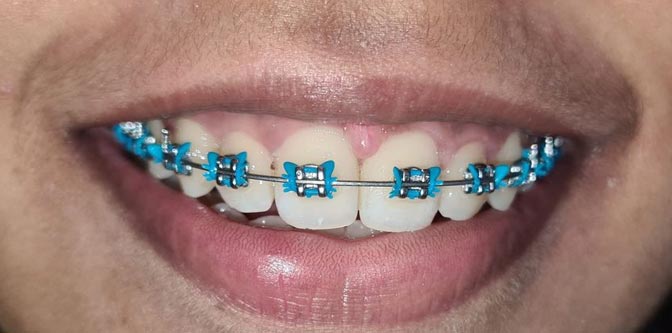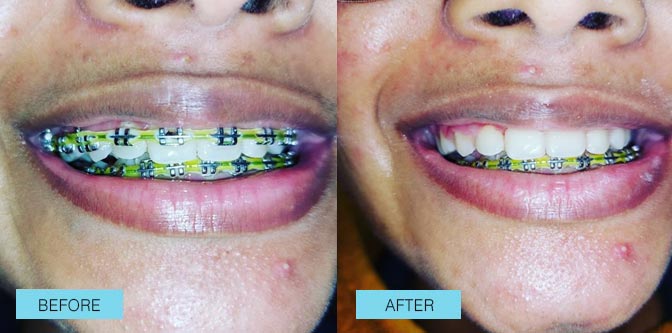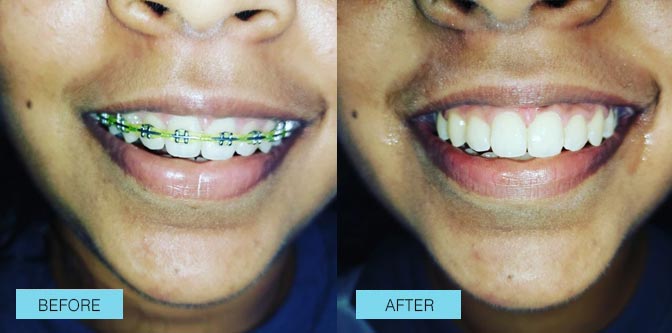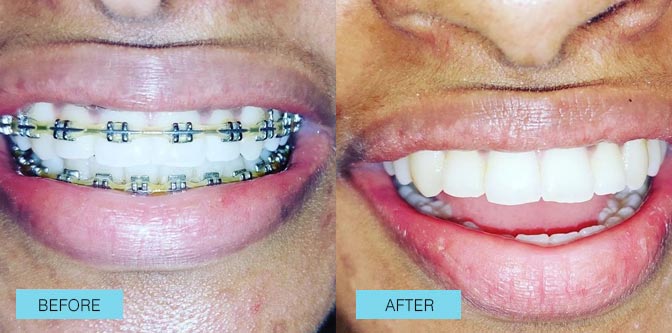






Orthodontics at Colombo Dental Clinic
We at Colombodental, are Sri Lanka’s number one ranked clinic. We specialize in tooth correction for past 15 years and will treat you with our pain-free advanced dentistry to correct your smile in the minimum time required, with kindness and compassion to give you an amazing smile.
NO dental extractions, NO tooth removal to correct your teeth!
Our treatment doesn’t cost or take time anywhere close to what you may imagine. Please WhatsApp us on link given above to get an idea of time and costs to give you the beautiful smile you deserve!!
Types of treatment
- Closing wide gaps between the teeth
- Aligning the tips of the teeth
- Straightening crooked teeth
- Improving speech or chewing ability
- Boosting the long-term health of gums and teeth
- Preventing long-term excessive wear or trauma of the teeth
- Treating an improper bite
Treatment can improve the appearance of the teeth, but it can also lead to better chewing and speech function and help protect teeth from damage or decay, in some cases.
To achieve these goals, we use a range of medical dental devices, plates, and braces.
Devices
Orthodontic devices can be fixed or removable.
Fixed appliances
These are the most common devices used in orthodontics. They are used when precision is important. A person can eat normally with fixed appliances, but some foods and drinks need to be avoided, such as carbonated drinks, hard candy, gum, and other sticky foods. People who participate in contact sports need to tell us, as they may need special gum shields.
Examples of fixed orthodontic appliances include:
Braces
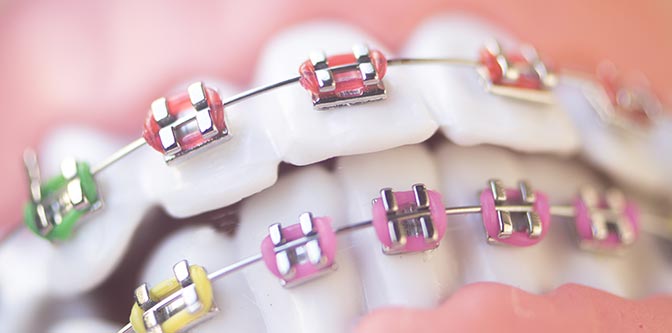
These consist of brackets, wires, and bands. Bands are fixed firmly around the teeth and serve as anchors for the appliance, while brackets are usually connected to the front of the teeth.
Wires in the shape of an arch pass through the brackets and are fixed to the bands. As the arch wire is tightened, tension is applied to the teeth. Over time, this moves them into proper position.
Follow-up involves monthly visits to adjust or tighten the braces. Treatment may last from several months to a number of years. Our treatment average duration is 6 months.
Both metal and crystal braces are available. Metal braces are more economical.
Fixed Expansion Devices:
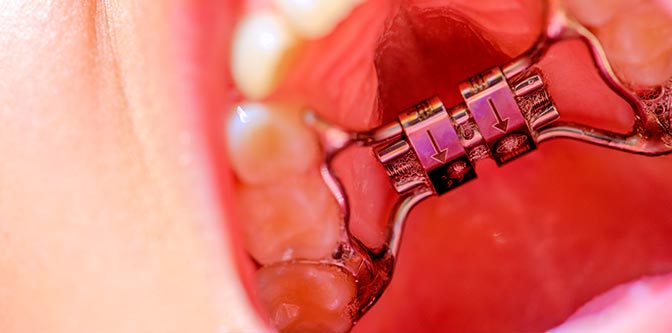
If you have teeth which are overlapping or are very irregular, this will be called crowding, which can be mild, moderate and severe. Crowding can also cause teeth to protrude out.
Conventional dental clinics, prescribe toot removal one from each side or even two!, but we never extract in 99% of our patients as extractions can cause imbalance in occlusion, and gaps may later form in teeth. Instead we use fixed expansion device on upper or lower jaw to expand and get space in your jaw to correct crowding. This appliance is usually followed with sectional or full braces
Removable orthodontic appliances
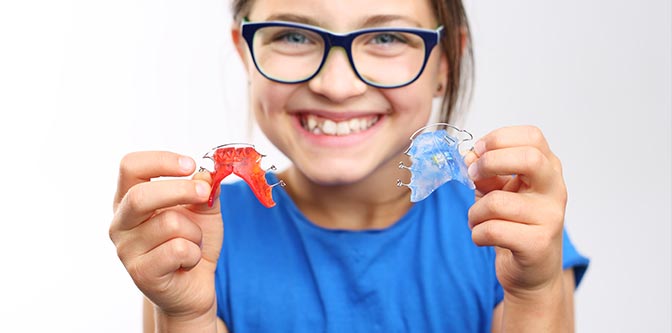
The appliance should only be taken out when cleaning, eating, or flossing. Sometimes, the orthodontist may advice the patient to remove them during certain activities, such as playing a wind instrument or cycling.
Examples of removable appliances include:
Palatal expander: This appliance is designed to make the arch of the upper jaw wider. It consists of a plastic plate with screws that is placed on the palate, or roof of the mouth. The screws put pressure on the joints in the bones, forcing them outward. This expands the size of the area in the roof of mouth.
Retainers: These are used after treatment to stop the teeth from moving back to their original positions. If modified, they may also be used to stop children from sucking their thumbs.
There are two types of removable retainer
Hawley retainer is made of metal and acrylic. The acrylic fits on the roof of the mouth and the wire surrounds the anterior teeth.
The other is made of clear plastic. It fits over the teeth and looks like an Invisalign aligner but is not.
We don’t recommend permanent retainers which are glued, or bonded, to the back of the teeth, unless absolutely indicated.
In some cases, with severe crowding it is recommended both a fixed permanent one on the lower anterior teeth and the clear plastic aligner-type which then would fit over the entire lower arch.
Should you visit us?
If you are not happy with your smile or bite, you should consider consulting us. When the jaws and teeth do not develop properly, malocclusion can result. The teeth will be crooked and misaligned, and the bottom and top sets of teeth may not line up.
Malocclusion is not a disease and it does not affect physical health. It is a variation in the position of teeth. However, it may impact the shape of the face and the appearance of the teeth, resulting in embarrassment, a lack of self-confidence, and even depression.
Reasons include injury to the teeth or facial bones and frequent thumb or finger sucking, among others.
We can provide a night-time mouth guard to stop people clenching and grinding their teeth.
Severe malocclusion may affect eating, speech, and keeping the teeth clean.
Orthodontic treatment can help treat or improve the following:
Protruding front teeth: Treatment can improve the appearance and protects the teeth from damage during sports injuries or falls.
Crowding: In a narrow jaw, there may not be enough space for all the teeth. The orthodontist may remove one or more teeth to make room for the others.
Impacted teeth: This can happen when adult tooth does not emerge from the gum or bone, or only emerges partially.
Asymmetrical teeth: The upper and lower teeth do not match, especially when the mouth is closed but the teeth are showing.
Deep bite, or overbite: When the teeth are clenched, the upper ones come down too far over the lower ones.
Reverse bite: When the teeth are clenched, the upper teeth bite inside the lower ones.
Open bite: When the teeth are clenched, there is an opening between the upper and lower teeth. Underbite: The upper teeth are too far back, or the lower teeth are too far forward. Crossbite: At least one of the upper teeth does not come down slightly in front of the lower teeth when the teeth are clenched. They are too near the cheek or the tongue.
Spacing: There are gaps or spaces between the teeth, either because a tooth is missing, or the teeth do not fill-up the mouth. This is the opposite of crowding.
Good oral hygiene is essential before any orthodontic work can begin. When devices are placed on the teeth, food particles are more likely to become stuck. You will need to brush much more carefully and more often to prevent tooth decay during treatment.
Without good oral hygiene practices, there is a risk of tooth decay during treatment. We may also recommend avoiding fizzy drinks, sugary snacks, and other items that can lead to tooth decay.
On your first visit we will assess the state of your teeth, and the assessment will involve:
1. taking a full medical and dental health history
2. carrying out a clinical examination
3. taking x-rays of the teeth and jaw
We will give you all possible options for treatment which may differ on time, cost etc. so you can select what is best for you.
We will give you the smile you want in 4-9 months*at Colombo Dental Clinics!
Treatment times may vary, on age, level of malocclusion, patient cooperation and visits etc.
*under optimum conditions and ideal treatment


